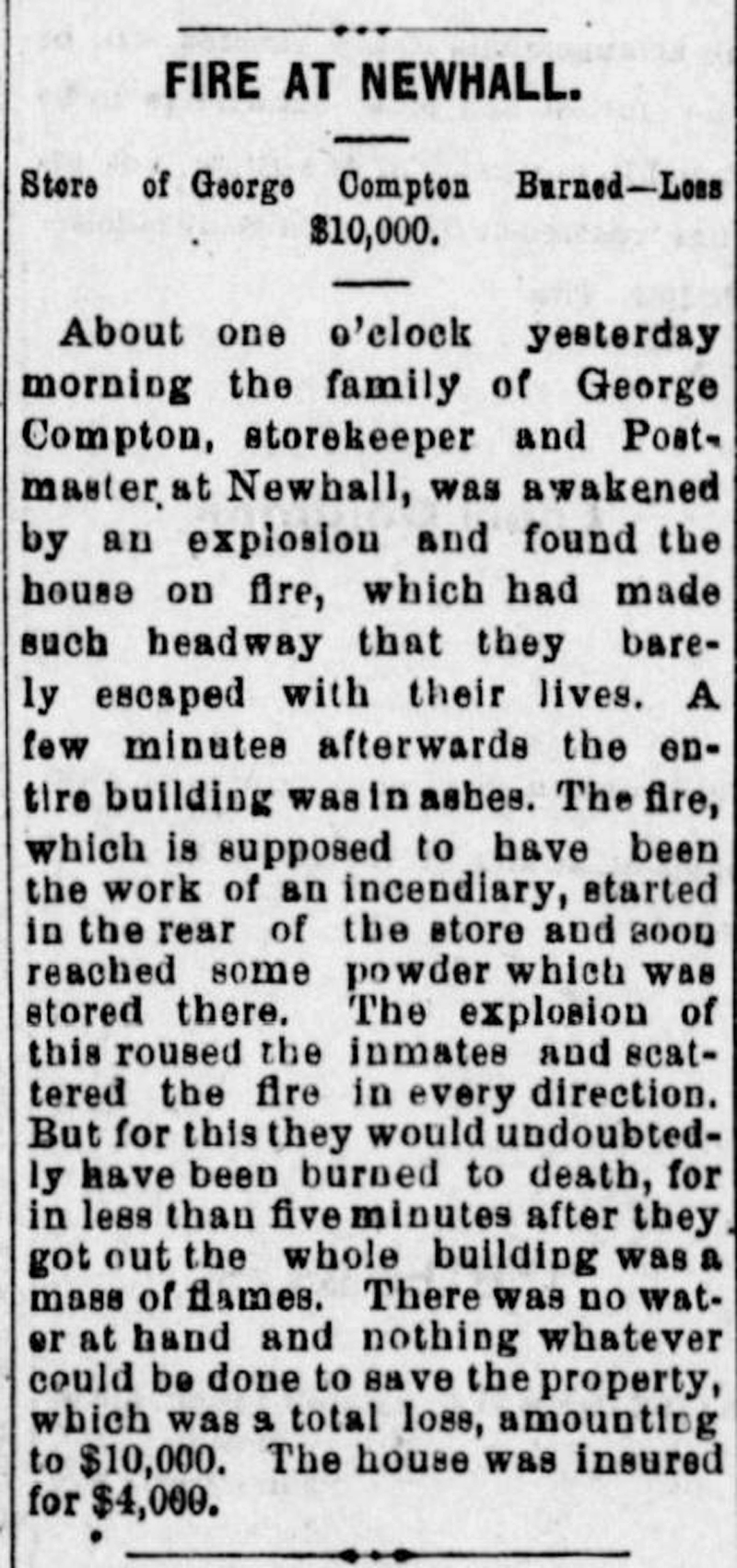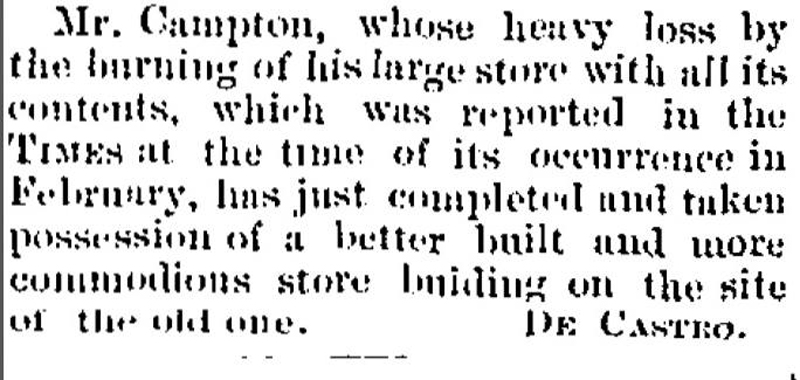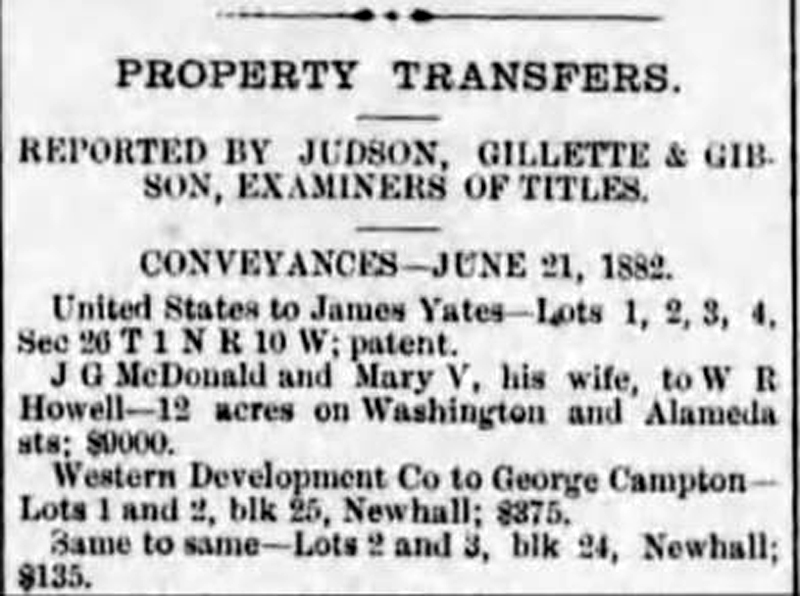|
|
Campton's Store Explodes and House Burns Down in Arson Fire.
March 3, 1882.
|
Webmaster's note. Apparently George Campton's general store blew up twice — once in 1882 and again in 1891 — meaning there were four different versions of Campton's store while under his ownership from 1876 to the turn of the 20th Century. Version 1 was the original structure at the original Newhall (today's Bouquet Canyon Road and Magic Mountain Parkway vicinity). Along with the rest of the town, Campton moved his store 2.5 miles south to 8th Street and Railroad Avenue in early 1878, erecting Version 2. It exploded in 1882, as reported here, when an arsonist torched it in the dark of night. The adjoining Campton home (at the northeast corner of 8th and Spruce) burned down with it; the family barely escaped with their lives. Campton replaced the store with Version 3. We have a bit of reconciling to do vis-a-vis photos that appear to show Versions 2 and 3 in the same location, but we learn here that in June 1882, Campton purchased more land from the Southern Pacific Railroad's real-estate development company — Lots 1 and 2 in Block 25 (southwest corner of 8th and Railroad) for his new store, and Lots 2 and 3 in Block 24 (one parcel distant from the northwest corner of 8th and Spruce) for his new house. See: Plat Map, Newhall 1889. Version 3 exploded in 1891 when flames again reached the stored ammo. Its replacement, again in the same location, was Version 4, which became Lindenfeld and Landell's, and eventually Bricker's. In light of this new information about the 1882 destruction of the store and home, we have several changes to make to the Campton pages on SCVHistory.com, and we'll remove this paragraph when we've made them. In the meantime, be aware that the Campton pages, as they relate to the fate of the building, are incorrect.
Fire At Newhall. Store of George Campton Burned — Loss $10,000. Los Angeles Herald | Saturday, March 4, 1882. About one o'clock yesterday morning the family of George Compton [sic], storekeeper and Postmaster at Newhall ,was awakened by an explosion and found the house on fire, which had made such headway that they barely escaped with their lives. A few minutes afterwards the entire building was in ashes. The fire, which is supposed to have been the work of an incendiary, started in the rear of the store and soon reached some powder which was stored there. The explosion of this roused the inmates and scattered the fire in every direction. But for this they would undoubtedly have been burned to death, for in less than five minutes after they got out the whole building was a mass of flames. There was no water at hand and nothing whatever could be done to save the property, which was a total loss, amounting to $10,000. The house was insured for $4,000. News story courtesy of Tricia Lemon Putnam. Note: The L.A. newspapers frequently misspelled his name as "Compton." George Campton was the son of a British army officer and came to California by way of the British West Indies and Canada; it's possible he pronounced his name more like "Compton" than "Campton."
Newhall. A Big Fire Night Before Last — A Ten Thousand Dollar Loss. Los Angeles Times | Saturday, March 4, 1882. Night before last there was quite a fire at Newhall about one o'clock. It is supposed that some enemy to George Campton set fire to his store. Mr. Campton's dwelling house was adjoining the store and was also completely destroyed. The family were aroused by the explosion of gunpowder in the store, and came near getting caught by the flames before they got out of the house. The postoffice was in the store and everything was lost. The property was valued at ten thousand dollars and insured for four thousand. News story courtesy of Tricia Lemon Putnam.
[Brief.] Los Angeles Times | Sunday, April 30, 1882. Mr. Campton, whose heavy loss by the burning of his large store with all its contents, which was reported in the Times at the time of its occurrence in February [sic], has just completed and taken possession of a better built and more commodious store building on the site of the old one. — De Castro. News story courtesy of Tricia Lemon Putnam.
Property Transfers.
Reported by Judson, Gillette & Gibson, Examiners of Titles. Los Angeles Herald | Thursday, June 22, 1882, pg. 3. United States to James Yates — Lots 1, 2, 3, 4, Sec 26 T 1 N R 10 W; patent. J G McDonald and Mary V, his wife, to W R Howell — 12 acres on Washington and Alameda sts: $9,000. Western Development Co to George Campton — Lots 1 and 2, blk 25, Newhall; $375. Same to same — Lots 2 and 3, blk 24, Newhall; $135. News story courtesy of Tricia Lemon Putnam. Note: Western Development Co. was the real-estate development arm of the Southern Pacific Railroad, which laid out both the old, original Newhall of 1876 and the "new" Newhall of 1878.
|
See Also: • Railroad Avenue Biography 1889 
Campton Story by Pollack 
House Obituary |
The site owner makes no assertions as to ownership of any original copyrights to digitized images. However, these images are intended for Personal or Research use only. Any other kind of use, including but not limited to commercial or scholarly publication in any medium or format, public exhibition, or use online or in a web site, may be subject to additional restrictions including but not limited to the copyrights held by parties other than the site owner. USERS ARE SOLELY RESPONSIBLE for determining the existence of such rights and for obtaining any permissions and/or paying associated fees necessary for the proposed use.










